Alfonso X el Sabio, 1221-1284.
Cantigas de Italia
Eduardo Paniagua, Grupo de Música Antigua
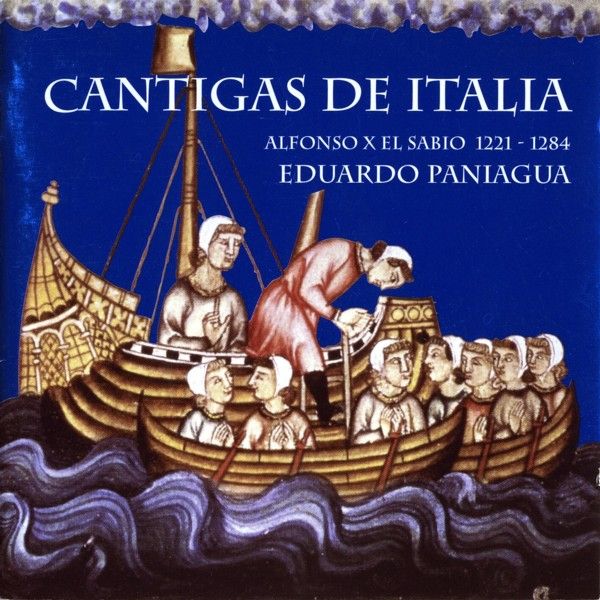
medieval.org
Sony "Hispánica" SK 60843 —
1998
Pneuma PN-510 — 2003
1. LAS PIERNAS
[Porque ben Santa Maria] [3:17]
CSM 327
gaita, kaval, gaita charra con tambor, flauta tenor, darbuga, agual,
tar, pandereta
2. EL JUGLAR DE LOMBARDÍA.
Par Deus muit' é gran dereito [4:46]
CSM 293
sopranos 1 & 2, coro — vihuela, bandurria, kaval, bendir,
espadilla, dos carracas
3. EL PAPA LEÓN DE ROMA.
Quen souber Santa Maria [6:31]
CSM 206
bajo, coro — zanfona, bandurria, fahl, chirimía, canno,
agual, tar, sistro de madera
4. ÍDOLOS DE SICILIA.
Com' en si naturalmente a Virgen [10:38]
CSM 335
sopranos 1 & 2, contratenor, tenor, bajo —
vihuela, arpa, fídula, axabeba, fahl, órgano
portátil, darbuga, tar
5. CIEGO POR EL DEMONIO
[Como o demo cofonder] [3:06]
CSM 407
siringa, axabeba, bandurria, tambor con tensores, carraca
6. LA IMAGEN DE FOGGIA DE APULIA.
Poi-las figuras [6:23]
CSM 136
contratenor, coro — órgano portátil, axabeba, arpa,
fídula, salterio, címbalos
7. EL PÚLPITO DE SIENA.
Non conven aa omagen [5:46]
CSM 219
tenor, coro — zanfona, salterio, flauta de tres agujeros con tambor,
campanil
8. EL OBISPO DE PAVÍA.
Muito punna [5:16]
CSM 87
sopranos 1 & 2, coro — cálamo, fídula, salterio,
pandero
9. CLÉRIGO CIEGO
[Santa Maria poder á] [2:17]
CSM 92
flautas pastoriles, cántaras, címbalo
10. LA CASULLA DE TURÍN.
Ben pod' as cousas feas [4:43]
CSM 73
tenor, contratenor, bajo, coro — zanfona, fídula, tromba
marina
11. EL CLÉRIGO DE PISA.
Quen leixar Santa Maria [9:48]
CSM 132
tenor, contratenor, coro — salterio, axabeba, bandurria, darbuga,
pandereta

MUSICA ANTIGUA
Eduardo Paniagua
Paula Vega, soprano 1
Patricia Paz, soprano 2
Luis Vincent, contratenor, canno
César Carazo, tenor, fídula
Germán Torrellas, bajo
Felipe Sánchez, vihuela de péñola,
bandurria medieval
Rafael Martín, zanfona
Javier Coble, siringa
Enrique Almendros,
arpa, chirimía, gaita, flauta de tres agujeros con tambor,
gaita charra con tambor
Jaime Muñoz, axabeba, kaval, cálamo
Luis Delgado,
órgano portátil, tromba marina, darbuga, bendir,
tambor con tensores
Eduardo Paniagua,
salterio, flautas a bisel tenor, fahl, flauta
pastoril, campanil, darbuga, agual, tar, sistro de madera, espadilla,
carraca, címbalos
(Todos los instrumentos utilizados son reproducciones de originales)
[Sony]
Sonido: Tyrel - Luis Carlos Esteban y Javier Coble
Portada: Miniatura de la Cantiga 35
Fotografías de las miniaturas de las Cantigas: Carlos y Eduardo Paniagua / Oronoz
Códice original de la Biblioteca del Monasterio de El Escorial
Diseño gráfico: Luis Vincent
Producido por EDUARDO PANIAGUA
Supervisor de Hispánica: RAFAEL PÉREZ-ARROYO
℗ © 1998 SONY MUSIC Entertainment (SPAIN), S.A.
[Pneuma]
Portada: Cantiga 35
Licenciado por Sony Music Entertainment Spain, S.A.
Depósito Legal: M-10375-2003
Grabado en diciembre de 1997 y enero de 1998
Sonido: Tyrel, Luis Carlos Esteban y Javier Coble
Diseño gráfico: Pneuma
Distribución: Karonte
Producción: EDUARDO PANIAGUA • 2003 PNEUMA
English liner notes
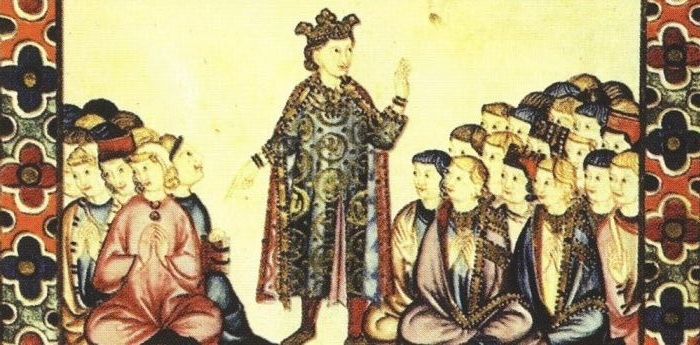
CANTIGAS DE ITALIA
Desde la abdicación en el año 476 del último
emperador romano de Occidente, hasta la historia reciente, dejó
de existir en Italia la unidad política. El reino lombardo, con
capital en Pavía durante 200 años, incorporaba la actual
Lombardía y gran parte de Venecia, Liguria y Toscana.
La fundación en el siglo IX del Sacro Imperio Romano por
Carlomagno determinó las líneas principales de la
historia de Italia, ligando su destino a las naciones del Norte. Por
otro lado la conquista de Sicilia en este mismo siglo por los
árabes marcó el apogeo sarraceno en Europa y la brillante
civilización musulmana, que heredaron los soberanos cristianos
de Sicilia. En el Sur de Italia el máximo poder seguía
siendo el del imperio bizantino, completado por los estados
marítimos italianos de Nápoles, Gaeta y Amalfi.
Hacia el año 1015 caballeros normandos sometieron el Sur de
Italia llegando a conquistar la isla de Sicilia a los sarracenos,
creando un reino independiente. En esta corte normanda se reunieron
sabios judíos, griegos y árabes, y el influjo de sus
conocimientos repercutió en toda Europa occidental.
El papado en el siglo XI, emancipado de la nobleza romana,
encabezó una reforma de la iglesia, tanto moral como intelectual
y política. Comenzó el largo conflicto entre el Papa y el
emperador del Sacro Imperio.
Urbano II incitó a Europa a la primera cruzada contra el Islam.
Y Calixto II y el emperador Enrique V en 1122, llegaron a compromisos a
favor del Papa en la cuestión de las investiduras, es decir, el
control sobre las elecciones de obispos.
El renacer del comercio Mediterráneo, después del
sometimiento de los sarracenos, hizo posible el comienzo de la
industria y del movimiento urbano de vanguardia: las ciudades-estado,
especialmente las repúblicas marítimas de Venecia,
Génova y Pisa.
En 1154 el emperador Federico I de Hohenstaufen - Barbarroja - cruza
los Alpes, y su poder es reconocido en toda Italia salvo en Venecia y
en el reino de Sicilia.
Inocencio III (1198-1216) marcó el cenit del poder papal, tanto
en su aspecto temporal como espiritual. Fue el verdadero fundador de
los Estados de la Iglesia y, curiosamente, fue quien aprobó la
orden de Francisco de Asís.
Federico II (1194-1250), nieto de Barbarroja y medio normando por su
madre Constanza, coronado en Roma por Honorio III, unió las
coronas de Sicilia y del Imperio. Fue denominado "Stupor Mundi"
(Asombro del mundo) favoreciendo en su corte el centro de una rica
civilización de ciencia, filosofía y arte, donde
cristianos, musulmanes y judíos gozaban de igual libertad
religiosa. Mas tarde, excomulgado y depuesto, inició la lucha
entre los gibelinos imperiales Hohenstaufen y los güelfos, aliados
de los papas y seguidores de su rival Otón Welf.
Con la muerte de los descendientes de Federico II se inicia la
intervención de Francia en Italia a través de Carlos de
Anjou, triunfando la causa güelfa en toda Italia. Poco
después, en 1282, tras las "Vísperas Sicilianas", los
soldados del rey Pedro de Aragón preludian la dominación
española del Sur de Italia.
Alfonso X fue el monarca más brillante e internacional de la
Edad Media en la Península Ibérica por lo universal de su
cultura y por la ambición de sus empresas artísticas y
culturales.
En Alfonso X confluyen las grandes dinastías de la Europa de su
época: evidentemente la castellano-leonesa, pero también
la inglesa a través de su bisabuela Leonor de Inglaterra, mujer
de Alfonso VIII de Castilla, el vencedor de Las Navas de Tolosa, e hija
de la protectora de trovadores la gran Leonor de Aquitania. Por su
madre Beatriz de Suabia, Alfonso X venía del linaje del imperio
de los Staufen y del linaje de los Comnenos, emperadores bizantinos.
Sobrino de Federico II, fue heredero de los derechos sucesorios del
Sacro Imperio Romano Germánico. Por su tío san Luis IX de
Francia estaba emparentado con la dinastía de los Capetos, y por
su matrimonio con Violante de Aragón fue yerno de Jaime I el
Conquistador. Suegro de Alfonso III de Portugal y cuñado de
Eduardo I de Inglaterra, Alfonso X fue uno de los personajes mas
destacados de la cristiandad, y su política cultural
difundió su fama por el Magreb y por Ultramar y el levante
islámico.
En 1256 fallecía el anti-emperador Guillermo II de Holanda,
antagonista del excomulgado Federico II Hohenstaufen, que había
muerto en 1250, igual que su hijo y sucesor Conrado IV que murió
en 1254. Ante esta situación los gibelinos de la
república de Pisa reconocieron para Alfonso X la corona del
imperio. Esta aspiración se mantuvo hasta la entrevista de
Alfonso X con el papa Gregorio X en Belcaire en 1275, donde
definitivamente se abandona este proyecto imperial, que hubiera dado
mayor importancia aún a la obra científica y cultural de
Alfonso X, y que hubiera implicado la extensión de su influencia
al ducado de Suabia, el reino de Italia y el mismo imperio.
Los milagros de las Cantigas, aunque variados y pintorescos, por el
carácter del cancionero quedan dentro del contexto del trovador
que ofrece a su amada Santa María un mosaico de las
hazañas de la propia Virgen. Este trovador es el Rey-poeta
Alfonso X, tantas veces dibujado en las miniaturas como mediador entre
los hombres y los seres celestiales. Así el trovador-rey termina
convirtiendo a todos los receptores de las canciones de su obra en
trovadores de la Virgen.
EDUARDO PANIAGUA
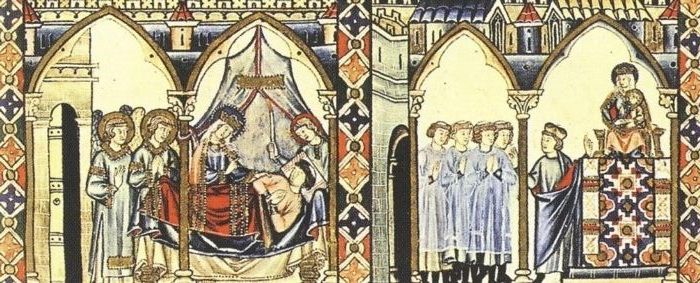
CANTIGAS DE ITALIA - ALFONSO X EL SABIO 1221-1284
1 - CSM 327. LAS PIERNAS
Interpretada instrumentalmente, tiene ritmo binario y repite 4 veces la
misma frase musical en el estribillo, 4 veces en la estrofa y 4 en la
coda, variando la terminación en abierta o cerrada, lo que le da
carácter antiguo y popular. Santa María guarda a un
clérigo al que se le volvieron las piernas hacia atrás
porque se hizo unos calzones con el paño que cubre el altar.
2 - CSM 293. EL JUGLAR DE LOMBARDÍA
Cantiga excepcional, con melodía obsesiva, atractiva y atrevida
de ritmo binario. En el códice de Florencia tiene el
número F-37. Al final de la primera estrofa se dice: 'se produjo
un gran milagro del que hice cantar y música", ("avêo un
gran miragre, onde fiz en cobras e son"), lo que nos señala que
el autor del texto y de la melodía no fue otro que el mismo
poeta real. La parodia del juglar imitador se prestaría a bromas
teatrales a las que da pie esta música simple y compleja, en la
que los cantores no tienen pausa para respirar, teniendo que alternarse
entre ellos para dar continuidad a la obra, problema resuelto con los
instrumentos de viento con la técnica de "respiración
continua". Esta cantiga pertenece a la tradición del Sacro
Imperio Germánico, bajo cuyo dominio estaba Lombardía, en
la que se localiza su historia, y su protagonista es un juglar
remedador, es decir imitador, que hace burla del personaje popular al
que suplanta. Este juglar tenía mucho éxito y
recibía buenos obsequios por su habilidad. Un día ante
una bellísima imagen de la Virgen se le ocurrió imitarla
burlescamente y al momento se le tornó la boca y el pescuezo de
tal modo que la barba se le quedó cerca de la oreja y el cuello
junto al brazo, cayendo al suelo. Lo llevaron a la iglesia y él
se lamentaba pidiendo perdón por sus pecados. Al día
siguiente durante la misa, por compasión de la Virgen Santa
María, fue curado recuperando su natural postura.
3 - CSM 206. EL PAPA LEÓN DE ROMA
Esta cantiga tiene una melodía polirrítmica y su
construcción es exclusiva en el cancionero.
La copla repite cuatro veces la misma melodía con ritmo quebrado
4-3-3 y la mudanza -o final de la copla- termina en varios compases de
ritmo ternario trocaico, que contrastan con el binario de su inicio y
del estribillo. Todo esto le da una complejidad semejante a la del rico
folklore mediterráneo. En el códice de Florencia es el
número F-54, teniendo variantes en las coplas números 5,
6 y 7 respecto al códice de San Lorenzo de El Escorial. En la
presente interpretación se ha seguido el de Florencia por ser
más expresivo el texto. Parece tratarse de una leyenda que
cuenta la tentación carnal, sin base histórica
comprobada, que le sucedió al papa San León IX, muerto en
1054. El diablo quiso tentar al papa con la seductora hermosura de una
mujer que durante la celebración de la misa en San Pedro,
después del evangelio, presentó la ofrenda
besándole la mano. El beso produjo tal desazón y
obsesión en el papa que decidió serrarse la mano.
Pasó mucho tiempo sin poder decir misa ni predicar en las
fiestas. Le pidió ayuda a la Virgen, y Santa María viendo
su deseo de servirla, le aplicó un ungüento, cesando el
dolor y colocándose de nuevo la mano sin dejar rastro de la
mutilación.
4 - CSM 335. ÍDOLOS DE SICILIA
Cantiga grande (cuyo número termina en cinco), con doce
miniaturas a doble página y con 21 estrofas. De melodia muy
bella, para cuya instrumentación se han cuidado matices
tímbricos variados, alternando el arpa y la vihuela, la viola y
la axabeba y el órgano de mano y la flauta árabe (fahl),
con ritmo binario a ocho partes tratado con la fracción andalusi
(3+3+2). Es la última cantiga del códice de Florencia,
F-103.
Según H. Anglés la transcripción de
melodías como esta da la pauta para hacerlo correctamente con
las "laudí" italiana de texto latino. Esta cantiga ha sido
grabada en versión instrumental en las Cantigas de Jerez de la
serie Hispánica. El tema de la cantiga es la conversión
de un infiel caritativo. En Sicilia un acaudalado hombre, que no
creía en Dios y adoraba a los ídolos, era generoso con
los pobres. En un año malo dio todo lo que tenia, y la Virgen se
le apareció en figura de mujer pobre con el niño en
brazos pidiéndole comida para la criatura. Sabiendo que
tenía el almacén vacío metió la mano por si
quedaba algo de harina, una poca encontró y él mismo hizo
una papilla. Quiso entregársela a la mujer pero ya no estaba
allí. Mandó buscarla sin resultado. Cuando regresó
a casa halló las arcas llenas de trigo, cebada y harina.
Reflexionando sobre este hecho maravilloso preguntó a los
entendidos, sin encontrar respuesta. Si existía alguna diosa con
un niño en brazos. Buscó entre los cristianos que le
mostraron la imagen de la Virgen Santa María, hablándole
de su hijo Jesucristo y de Dios en trinidad. El gentil pidió ser
bautizado dando loores a la Virgen gloriosa.
5 - CSM 407. CIEGO POR EL DEMONIO
 Interpretada instrumentalmente.
Interpretada instrumentalmente.
La construcción musical es exclusiva de esta cantiga: aa/bb/cc.
Es de ritmo trocaico y parece ser un canto de procesión. Aparece
únicamente en el códice de Toledo como número 10
del Apéndice Segundo y con anotación del n° XII.
Santa María hace ver a un hombre que quedó ciego por
encomendarse al demonio.
6 - CSM 136. LA IMAGEN DE FOGGIA DE APULIA
Para su interpretación se ha utilizado la melodía
especular.
Reinando Conrado IV (1250-1254), hijo del emperador Federico II y primo
del rey Alfonso X, gentes de su séquito jugaban a los dados
frente a la iglesia de la villa de Foggia. Una mujer alemana,
tahúra, al perder en el juego y llena de ira tiró una
piedra que alcanzó la imagen de Santa María al punto de
herir el rostro del niño. La madre alzó el brazo para
proteger a su hijo y la piedra le agujereó el codo. Enterado el
rey de esta maravilla arrestó a la mujer, y mandando restaurar
la imagen, no pudieron poner el brazo como estaba antes, quedando como
testimonio de este hecho.
7 - CSM 219. EL PÚLPITO DE SIENA
Melodía que sabiamente conjuga lo popular y lo litúrgico.
Se ha optado por enfatizar el ritmo ternario que la acerca a lo popular
y utilizando el juego de campanas que puede recordar su relación
con lo litúrgico.
Relato localizado en la catedral de Siena, en la que debía haber
un cancionero pues en la última estrofa el obispo iba a "poner
este milagro entre los de Santa María". Se trata de un duelo
entre las figuras opuestas de la Virgen y Satán, con victoria de
la primera. El obispo mandó labrar un púlpito de rico
mármol. Los escultores hicieron la imagen de Santa María
con su niño en un mármol blanquísimo. Entre las
otras muchas escenas aparecía deforme la figura del demonio
también en mármol muy limpio. La Virgen contrariada
obró el milagro de volver negra esta fea figura. Los fieles y el
obispo, pensando que era una broma, lavaron y rasparon el negro demonio
sin éxito. El obispo lloroso ante el altar pidió
perdón a la Virgen por no haber tenido finura y utilizar el
mismo mármol en las dos imágenes antagónicas,
mandando escribir esta historia.
8 - CSM 87. EL OBISPO DE PAVÍA
En la ciudad de Pavía Santa María mandó que
hiciesen obispo al clérigo que decía siempre sus "horas".
A un hombre santo se le apareció la Virgen y le indicó
que el que llamaban Jerónimo debería ser obispo. El
hombre santo se lo contó al cabildo y todos de acuerdo hicieron
elección del clérigo Jerónimo.
Este milagro es recogido en España por Gil de Zamora y Berceo.
La melodía y la métrica de esta cantiga tienen la
peculiaridad de tener un doble refrán o estribillo. Uno fijo a
modo de entrada: "Mucho se afana siempre Santa María por honrar
a los suyos"; y otro que varía en cada estrofa el verso, aunque
el contenido sea la misma idea: "A los suyos honrará siempre
Santa María".
9 - CSM 92. CLÉRIGO CIEGO
Instrumental con flauta pastoril.
La historia narra como un sacerdote ciego recobra la vista durante la
misa por mediación de la Virgen María.
El texto juega con la palabra "Lume" - luz: la que da la "luz", la que
es "luz" y la que dio "a luz" a Jesús.
10 - CSM 73. LA CASULLA DE TURÍN
Localizado este milagro en la abadía de San Michele de Chiusa,
cerca de Mont Cenis.
Para la fiesta de Navidad los monjes benedictinos preparaban la misa.
El tesorero cogió una casulla blanca y en la otra mano
tomó vino muy bermejo para la celebración. Tropezó
con una piedra y vertió el vino sobre la casulla dejando una
mancha como sangre fresca. El monje por miedo al abad quiso huir,
pidiendo ayuda a la Virgen Santa María. Esta hizo que la casulla
quedara más blanca que al principio, acudiendo por este hecho
muchos romeros desde lejos a venerar la casulla. El milagro tiene
carácter simbólico como explica el estribillo. "Bien
puede trocar las cosas feas en hermosas, la que puede lavar los pecados
de las almas".
Por tener la melodía una extensión en el ámbito de
una 4ª y repetir la misma melodía seis veces entre el
estribillo y la copla, se tiene como ejemplo de las melodías de
cantar de gesta o en cualquier caso su arcarcismo hace suponer que sea
una melodía anterior a la propia cantiga.
11 - CSM 132. EL CLÉRIGO DE PISA
Un clérigo que había prometido castidad a la Virgen
renuncia al matrimonio en su noche de bodas.
En Pisa un clérigo de rica familia, pero muy humilde,
tenía gran devoción de Santa María, y por la
virginidad de ella guardaba la suya. Al morir sus padres tuvo rica
herencia y fue presionado a casarse con una bella mocita doncella de
las más ricas de esa tierra. Mientras llegaban los convidados a
la boda entró a rezar en la iglesia y quedó dormido. Se
le apareció la Virgen y le hizo grandes reproches, celosa de la
joven recordando sus promesas de amor. El quedó conmocionado,
pero se celebró la boda. En el lecho nupcial quedaron a solas y
él vio el pecho de ella, y luego se abrazaron creyendo ella que
iba a poseerla. Pero el novio no pudo a pesar de desearla. Entonces se
levantó, dejó toda la riqueza y vivió pobremente
el resto de su vida.
Eduardo Paniagua
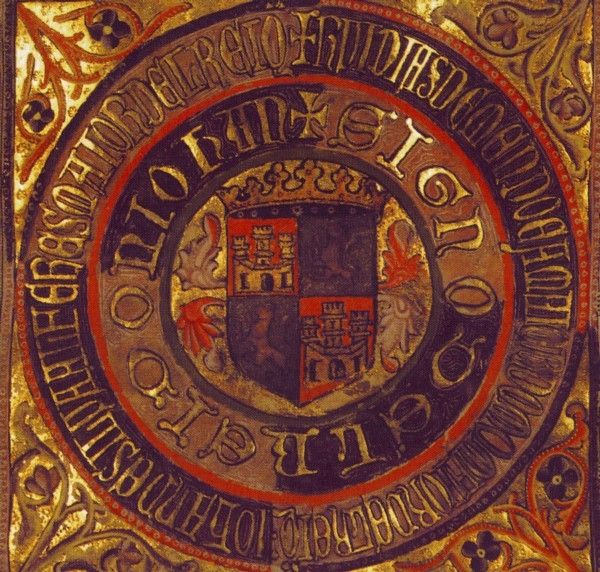
CANTIGAS OF ITALY
After the abdication of the last Western Roman
Emperor in the year 476, the political unity in Italy ceased to exist
until recent times. The Lombard kingdom, with Pavia as its capital for
200 years, comprised the present Lombardy and a great part of Venice,
Liguria and
Tuscany.
The foundation of the Holy Roman Empire
by Charlemagne in the 9th century determined the main lines in the
history of Italy, sharing its fate with the Northern regions. On the
other hand, the conquest of Sicily by the Arabs in the same century
marked the peak of Saracen success in Europe and the brilliant Muslim
civilization, which would be inherited by the Christian kings of Sicily.
In the South of Italy the Byzantine Empire continued to be the
strongest power, coupled with the Italian maritime states of Naples,
Gaeta and Amalfi.
Towards the year 1015 Norman knights forced the
South of Italy to yield; they even conquered the island of Sicily from
the Saracens, creating an independent kingdom. In this Norman Court
learned Jews, Greeks and Arabs would gather together, and the influence
of their knowledge had repercussions in the whole of Western Europe.
In
the 11th century the papacy, emancipated from the Roman Nobility, led a
moral, intellectual and political reform in the Church. The long
conflict between the Pope and the Emperor of the Holy Roman Empire
began.
Urban II incited Europe against Islam in the first
Crusade. And in 1122 Calixtus II and the Emperor Henry V reached a
compromise in favour of the Pope as far as investitures were concerned,
that is, the control over the election of bishops.
The revival of
Mediterranean commerce, after the Saracen submission, enabled the
beginning of industry and of a progressive urban movement: city-states,
especially the maritime republics of Venice, Genova and Pisa.
In
1154 the Emperor Frederick I of Hohenstaufen -Barbarossa- crosses the
Alps, and his power is acknowledged in the whole of Italy, with the
exceptions of Venice and the kingdom of Sicily.
Innocent III
(1198-1214) marked the summit of the papal power, both temporally and
spiritually. He was the real founder of the Papal States and, curiously
enough, it was he who approved of the order of Francis of Assisi.
Frederick
II (1194-1250), Barbarossa's Grandson and a half-Norman through his
mother, Constanza, was crowned by Honorius III in Rome and joined the
crowns of Sicily and the Empire. He was known as "Stupor Mundi" (Wonder
of the World) and turned his court into the centre of a rich
civilization of science, philosophy and art, where Christians, Muslims
and Jews all enjoyed the same religious liberty. Later on, after he had
been excommunicated and deposed, he started the fight between the
imperial Ghibelines, Hohenstaufen, and the Guelfs, allied to the Popes
and followers of his rival Oton Welf.
The death of Frederick II's
descendants sets off France's intervention in Italy through Charles of
Anjou, and the Guelf cause triumphs in the whole of Italy. Soon
afterwards, in 1282, after the "Sicilian Vespers", the soldiers of King
Pedro of Aragon herald the Spanish domination in the South of Italy.
Alfonso
X was the most brilliant and cosmopolitan monarch of the Middle Ages in
the Iberian Peninsula because of the universality of his culture and
the ambition of his artistic and cultural enterprises.
The
greatest dynasties in the Europe of that time merge in Alfonso X: that
of Castile-Leon, of course; but also the English one, through his
great-grandmother Eleanor of England -wife of Alfonso VIII of Castile,
victor at Las Navas de Tolosa, and daughter of the troubadours'
protectress, the great Eleanor of Aquitaine. Through his mother Beatrice
of Swabia, Alfonso X was descended from the lineage of the Staufen
Empire and from that of the Comnenus Byzantine Emperors. As Frederick
II's nephew , he inherited the rights of succession to the Holy Roman
Germanic Empire. Through his uncle Saint Louis XI of France, he was
connected with the Capet dynasty, and through his marriage to Violante
of Aragon he became son-in-law to Jaime I the Conqueror. Father-in-law
of Alfonso III of Portugal and brother-in-law of Edward I of England,
Alfonso X was one of the most remarkable characters of Christendom, and
his cultural policy spread his fame over the Mahgrib and through
Outremer and the Islamic East.
The year 1256 saw the death of the
anti-Emperor William II of Holland, antagonist of the excommunicated
Frederick II of Hohenstaufen, who died in 1254. Under these
circumstances, the Ghibelines of the Republic of Pisa acknowledged
Alfonso X's claim to the crown of the Empire. This aspiration lasted
until Alfonso X's interview with Pope Gregory X in Belcaire in 1275,
which put paid to that imperial project which would have enhanced the
importance of Alfonso's scientific and cultural work even further, and
which would have entailed the extension of his influence over the Duchy
of Swabia, the Kingdom of Italy and the Empire itself.
Given the
character of the songbook, the miracles in the Cantigas, though varied
and picturesque, remain within the context of the troubadour who offers
his Beloved, Saint Mary, a mosaic of the deeds of the Virgin Herself.
This troubadour is the mediator between men and celestial beings. Thus
the Troubadour-King transforms those who receive his songs into
troubadours of the Virgin.
E. PANIAGUA - Translation: Santiago Sanz
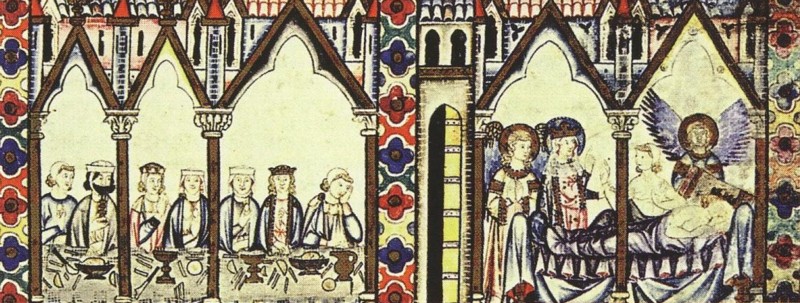
CANTIGAS OF ITALY - ALFONSO X EL SABIO 1221-1284
1. CSM 327. THE LEGS
Performed
instrumentally, it has a binary rhythm and repeats the same musical
phrase four times in the refrain, four times in the stanza and another
four in the coda, alternating open and closed endings, which gives it an
ancient and popular character. Saint Mary protects a clergyman who had
his legs turned backwards because he had made himself a pair of breeches
out of the cloth that covered the altar.
2. CSM 293. THE MINSTREL OF LOMBARDY
An
exceptional cantiga, with an obsessive, daring and attractive melody of
binary rhythm. It carries the number F-37 in the Codex of Florence. The
end of the first stanza reads: "a great miracle happened, about which I
wrote a song and music" ("avêo un gran mirage, onde fiz en cobras e
son"), which shows that the author of the text and the melody was no-one
but the poet himself. The parody of the minstrel impersonator lends
itself to theatrical jokes, which this simple, and at the same time
complex, music gives rise to. Here the singers have no time to breathe,
so they must alternate with one another to maintain the continuity of
the piece, a problem which the wind instruments resolve through the
technique of "circular breathing". This cantiga belongs to the tradition
of the Holy Germanic Empire, under whose domination was Lombardy, where
this story is located. Its protagonist is an imitating minstrel, that
is, an impersonator who makes fun of the character he takes off. This
minstrel was very successful and often received gifts acknowledging, his
skill. One day he was in front of the beautiful image of the Virgin
when he had the unfortunate idea of mocking it. All of a sudden his
mouth and neck suffered such a transformation that his beard ended up
next to his ear and his neck next to his arm, the man falling thus to
the ground. While he was being carried to the church, he lamented over
his sins and begged for forgiveness. The following day, during the mass,
he was cured by the pity of the Virgin Mary, and recovered his usual
countenance.
3. CSM 206. POPE LEO OF ROME
This
cantiga has a polyrhythmic melody and its structure is exclusive to the
songbook. The song repeats the same melody four times with a broken
rhythm 4-3-3, and its final verse ends with various bars of trochaic
ternary rhythm, which contrast with the binary ones at the beginning and
in the refrain. All of this endows it with a level of complexity
comparable to that of the rich Mediterranean folklore. It is number F-54
in the Codex of Florence, with variations in stanzas 5, 6 and 7 with
respect to the Codex of San Lorenzo de El Escorial. The present
performance has followed the Florence version, its text being more
expressive. This seems to be a legend that tells the story, without a
proven historical basis, of a temptation of the flesh suffered by Pope
Saint Leo IX, who died in 1054. The devil tried to tempt the Pope with
the seductive beauty of a woman who kissed his hand while presenting the
offering during the celebration of the mass in Saint Peter's, after the
gospel. The kiss plunged the Pope into such uneasiness and obsession
that he decided to saw his hand off. For a long time he was unable to
celebrate the mass or preach during festivities. He begged the Virgin
for help, and Saint Mary, who saw his desire to serve Her, applied some
ointment on his hand to kill the pain, and put it back on without
leaving a sign of the mutilation.
4. CSM 335. IDOLS OF SICILY
Great
cantiga (since its number ends in five), with twelve double-page
miniatures and 21 stanzas. It has a very beautiful melody, for whose
scoring we have paid attention to various shades of timbre, alternating
harp and vihuela, viol and axabeba and hand organ with Arabic flute
(fahl), with an eight-part binary rhythm treated with the Andalusi split
(3+3+2). This is the last cantiga in the Codex of Florence, F-103.
According
to H. Anglés, the transcription of melodies like this sets the example
for an accurate treatment of the Italian "laudi" with a Latin text. This
cantiga has been recorded in its instrumental version in the Cantigas
of Jerez from the Hispanic Series. The subject matter in this cantiga is
the conversion of a charitable infidel.
In Sicily a wealthy man, who
did not believe in God and worshipped idols, was, nevertheless,
generous to the poor. On one occasion he gave away everything he had,
for it had been a very bad year, and the Virgin appeared to him in the
shape of a very poor woman with her child in her arms, begging for food
for the little one. Although he knew his store-room was empty, he stuck
his hand in the flour sack in case there was some left, and with the
very little he found he himself made some porridge. He went to give it
to the woman, but she was not there any more. He sent to look for her,
without success. When he returned home he found his store-room full of
wheat, barley and flour. On thinking over this wonderful event, he
enquired of the learned men whether there was a goddess who held a child
in her arms; but he found no answer. When he looked among the
Christians they showed him the image of the Virgin Mary, and told him
about Her Son, Jesus Christ and the Holy Trinity. The pagan asked to be
baptised in praise of the glorious Virgin.
5. CSM 407. BLINDED BY THE DEVIL
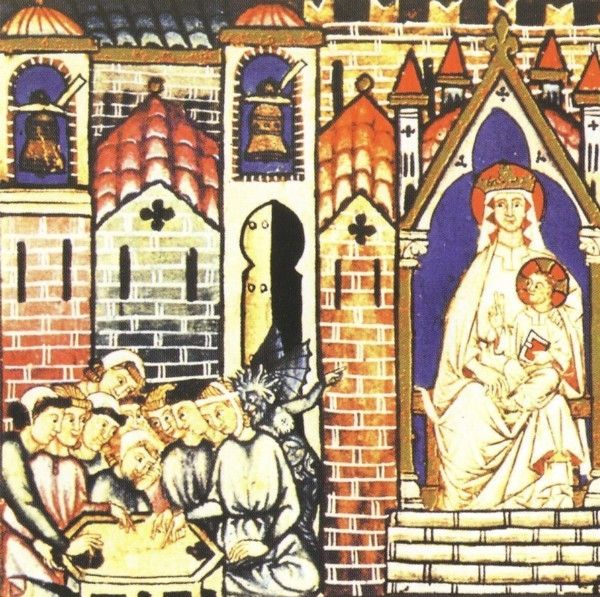 Performed
instrumentally. The musical structure is exclusive to this cantiga:
aa/bb/cc. It has a trochaic rhythm and sounds like a processional chant.
It only appears in the Toledo Codex as number 10 of Appendix II, and
with notes from number XII. Saint Mary gives his eyesight back to a man
who had lost it for entrusting himself to the Devil.
Performed
instrumentally. The musical structure is exclusive to this cantiga:
aa/bb/cc. It has a trochaic rhythm and sounds like a processional chant.
It only appears in the Toledo Codex as number 10 of Appendix II, and
with notes from number XII. Saint Mary gives his eyesight back to a man
who had lost it for entrusting himself to the Devil.
6. CSM 136. THE IMAGE OF FOGGIA IN APULIA
A
speculative melody has been used for the performance of this cantiga.
In the reign of Conrad IV (1250-1254), Emperor Frederick II's son and
king Alfonso X's cousin, some people from his retinue were playing dice
one day in front of the church of Foggia, when a German woman, a gambler
who was losing at her game, became so irate that she threw a stone,
reaching the image of Saint Mary, and was just about to damage the
Child's face; but the Mother lifted Her arm to protect Her Son, so the
stone hit and dented Her elbow. When the king heard of this marvel, he
had the woman arrested and ordered that the image should be restored;
but they were not able to make the arm look as it had done before, so it
remained as a testimony of this event.
7. CSM 219. THE PULPIT OF SIENA
A
melody which skilfully combines the sacred and the profane. We have
decided to place emphasis on the ternary rhythm, which brings it closer
to the popular; but also using the set of bells, to remember its
connection with the liturgic. This story is located in the cathedral of
Siena, where there must have been a songbook, since in the last stanza
the bishop was going to "place this miracle amongst those of Saint
Mary".
It treats of a duel between the opposing figures of the Virgin
and Satan, with victory of the former. The bishop ordered the building
of a pulpit out of valuable marble. The sculptors used the whitest of
marbles to shape the image of Saint Mary and Child. Among many other
scenes there appeared the deformed figure of the Devil, also in neat
marble. The Virgin, rather upset, worked the miracle of turning this
ugly figure black. The bishop and his congregation thought it had been a
joke, so they washed and rubbed the black demon without success. The
bishop, in tears in front of the altar, begged for the Virgin's
forgiveness, for having been so careless as to use the same marble for
the two antagonistic images, and ordered that this story be written
down.
8. CSM 87. THE BISHOP OF PAVIA
In
the city of Pavia Saint Mary ordered that the clergyman who always said
Her "hours" should be made bishop. The Virgin appeared to a holy man
and told him that he whom they called Hieronimus should become bishop.
The holy man told the chapter and they all agreed to elect the clergyman
Hieronimus. This miracle is collected in Spain by Gil de Zamora and
Berceo. The melody and the metre of this cantiga show the peculiarity of
having a double refrain: a fixed one as a way of introduction "Much
does Saint Mary labour to honour Her own", and another varying in each
verse, though often with similar content - "Saint Mary will always
honour Her own".
9. CSM 92. THE BLIND CLERGYMAN
Instrumental
with pastoral flute. The story tells how a blind priest recovers his
eyesight during the mass with the mediation of the Virgin Mary. The text
plays with the word "Lume" (light): She who gives the "light", She who
is "light" and She who brings Jesus into the "light" of the world, that
is, who gives birth to the Lord.
10. CSM 73. THE CHASUBLE OF TURIN
This
miracle is located in the abbey of San Michele di Chiusa, near Mont
Cenis. The Benedictine monks were preparing mass for the festivity of
Christmas, and the treasurer took a white chasuble in one hand and held
some deep red wine for the celebration in the other. But he tripped over
a stone and spilled the wine all over the chasuble, leaving a stain
like fresh blood on it. The monk wished to escape for fear of the abbot,
and so he begged the Virgin for help. She made the chasuble even whiter
than it was before. So, from then on, a great number of pilgrims would
arrive from very remote places to revere the chasuble. The miracle has a
symbolic character, as the refrain shows: "She that can wash the sins
off the souls, can also make ugly things beautiful". Since the extension
of the melody is within the limits of a fourth, and because the same
melody is repeated six times between the refrain and the song as such,
it has become an example of the melodies in epic poems or, in any case,
its archaic character leads us to suppose that this melody might be
earlier than the cantiga itself.
11. CSM 132. THE CLERGYMAN OF PISA
A clergyman who had promised chastity to the Virgin renounces matrimony on his wedding night.
In
Pisa a clergyman from a rich but humble family felt a great devotion
for Saint Mary, and in respect for Her virginity he decided to keep his.
When his parents died he came into a great fortune and was pressed into
marrying a pretty lass, one of the richest maidens around. While the
wedding guests were arriving, he entered the church to pray and fell
asleep. The Virgin appeared to him and showed herself greatly
reproachful, jealous of the young maid, recalling his love promises. He
was astounded; but the wedding was celebrated all the same. They were
left alone in the nuptial bed, he saw her bosom, they held each other
and she thought he was going to possess her. But the bridegroom was not
able to in spite of his desire. So he got up, abandoned all his wealth
and lived poorly ever after.
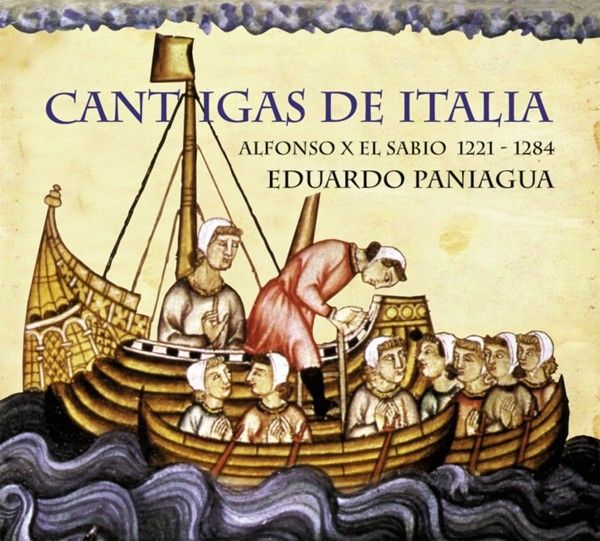




 Interpretada instrumentalmente.
Interpretada instrumentalmente.

 Performed
instrumentally. The musical structure is exclusive to this cantiga:
aa/bb/cc. It has a trochaic rhythm and sounds like a processional chant.
It only appears in the Toledo Codex as number 10 of Appendix II, and
with notes from number XII. Saint Mary gives his eyesight back to a man
who had lost it for entrusting himself to the Devil.
Performed
instrumentally. The musical structure is exclusive to this cantiga:
aa/bb/cc. It has a trochaic rhythm and sounds like a processional chant.
It only appears in the Toledo Codex as number 10 of Appendix II, and
with notes from number XII. Saint Mary gives his eyesight back to a man
who had lost it for entrusting himself to the Devil.